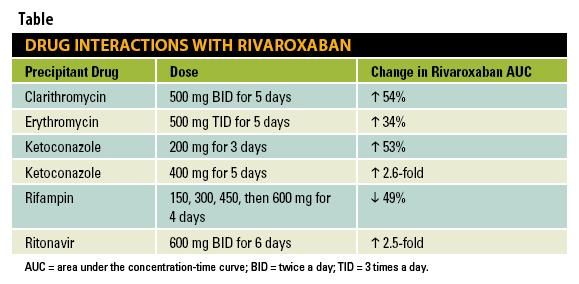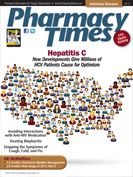Publication
Article
Pharmacy Times
Rivaroxaban: A New Oral Anticoagulant
As more patients begin medication regimens that include rivaroxaban, pharmacists should be aware of its known interactions.
As more patients begin medication regimens that include rivaroxaban, pharmacists should be aware of its known interaction.
Rivaroxaban (Xarelto) was recently approved as an oral anticoagulant (direct inhibitor of factor Xa) for prophylaxis of deep vein thrombosis and to reduce the risk of embolism in patients with atrial fibrillation. 1 Rivaroxaban is partially metabolized by cytochrome P450 (CYP) enzymes and is a substrate for efflux transporters. It is also eliminated by the kidneys, and reduced renal function will result in drug accumulation; dose reductions are suggested in patients with renal dysfunction. The Table summarizes drug interaction studies reported with rivaroxaban.

Rivaroxaban Pharmacology
The bioavailability of rivaroxaban is dose dependent. 2,3 It is reported to be about 80% to 100% for a 10-mg dose and about 66% for a 20-mg dose. Doubling the dose of rivaroxaban from 10 mg to 20 mg increases the area under the concentration-time curve (AUC) by only 60%. 2 Just as food has been shown to affect the absorption of the 20-mg dose more than the 10-mg dose, it is possible that the magnitude of change in rivaroxaban AUC during the coadministration of an elimination inhibitor or inducer may differ depending on the dose of rivaroxaban being studied. Except for the rifampin study, all reported drug interaction studies used a single 10-mg dose of rivaroxaban.
Approximately 50% of rivaroxaban is metabolized (CYP3A4 [major pathway] and CYP2J2, based on in vitro studies), and approximately 40% of a dose is eliminated unchanged by the kidneys. Renal elimination is primarily by active renal secretion, perhaps via P-glycoprotein (P-gp) or breast cancer resistance protein. Rivaroxaban has a half-life of approximately 5 to 12 hours. It has not been demonstrated to inhibit any CYP enzyme or active transporter.
Drug Interactions: CYP3A4 anD P-GP Based
Although rivaroxaban is a substrate for both CYP3A4 and P-gp, the only reported drug interactions have been with drugs that affect both of these elimination pathways. As can be seen in the Table, drugs considered to be potent inhibitors of both CYP3A4 and P-gp (eg, ketoconazole and ritonavir) produce the largest effect on the AUC of rivaroxaban.
Other drugs known to inhibit CYP3A4 and P-gp (eg, itraconazole, amiodarone, conivaptan, cyclosporine, posaconazole, telaprevir, and verapamil) would also be expected to interact with rivaroxaban and produce elevated rivaroxaban plasma concentrations and anticoagulant response. Without data on the potential interaction of rivaroxaban with pure CYP3A4 and P-gp inhibitors, it is difficult to estimate the magnitude of potential interactions, particularly with drugs that affect only CYP3A4 or P-gp.
Rifampin, a CYP3A4 and P-gp inducer, decreases the AUC of rivaroxaban by about 50%. Doses of rivaroxaban will likely require an increase during concurrent rifampin administration. Rifabutin, rifapentine, St. John’s wort, and carbamazepine may also reduce rivaroxaban concentrations.
Drug Interactions: Pharmacodynamic
As with any anticoagulant, the combination of 2 or more anticoagulants is likely to produce an increase in response. The addition of warfarin to rivaroxaban has been noted to produce an increased effect on factor Xa and prothrombin times. The use of antiplatelet drugs (eg, nonsteroidal anti-inflammatory drugs, clopidogrel, prasugrel, ticagrelor) with rivaroxaban should be carefully monitored for excess anticoagulation.
Clinical Significance
Clinical experience is limited, but some of the potential drug interactions are likely to alter patient response to rivaroxaban. The anticoagulant response to rivaroxaban is related to its plasma concentration. 2 Both renal and hepatic dysfunction increase the plasma concentration of rivaroxaban and increase its pharmacodynamic response. 1,4 These changes are similar in magnitude to those observed with drugs that inhibit rivaroxaban elimination.
Patients stabilized on rivaroxaban should be monitored for altered response (bleeding or loss of anticoagulant effect) if CYP3A4 or P-gp inhibitors or inducers are added to or removed from their drug regimen. The administration of other anticoagulants or antiplatelet drugs would be expected to increase the risk of bleeding in patients taking rivaroxaban. Patients with concurrent renal or hepatic dysfunction are likely to be particularly sensitive to drug interaction—induced changes in rivaroxaban elimination. PT
References
1. Xarelto [package insert]. Titusville, NJ: Janssen Pharmaceuticals, Inc; 2011.
2. Kubitza D, Becka M, Voith B, Zuehlsdorf M, Wensing G. Safety, pharmacodynamics, and pharmacokinetics of single doses of BAY 59-7939, an oral, direct factor Xa inhibitor. Clin Pharmacol Ther. 2005;78:412-421.
3. Mueck W, Borris LC, Dahl OE, et al. Population pharmacokinetics and pharmacodynamics of once- and twice-daily rivaroxaban for the prevention of venous thromboembolism in patients undergoing total hip replacement. Thromb Haemost. 2008;100:453-461.
4. Kubitza D, Becka M, Mueck W, et al. Effects of renal impairment on the pharmacokinetics, pharmacodynamics, and safety of rivaroxaban, an oral, direct Factor Xa inhibitor. Br J Clin Pharmacol. 2010;70:703-712.
Drs. Horn and Hansten are both professors of pharmacy at the University of Washington School of Pharmacy. For an electronic version of this article, including references if any, visit www.hanstenandhorn.com.







